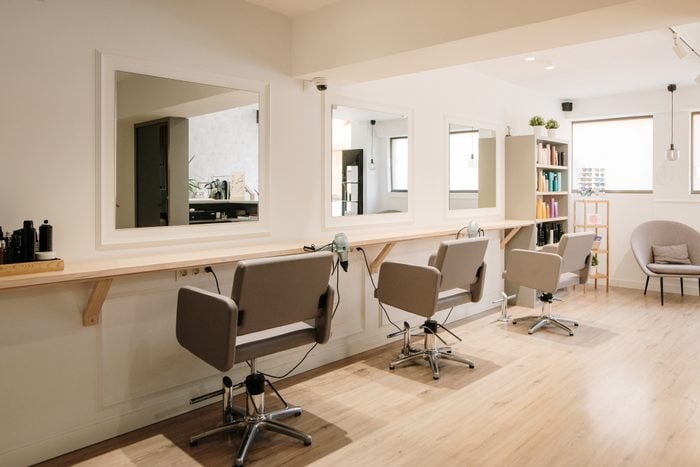
The dos and don’ts of going to the salon
Outside of family and friends, one of the most important relationships you can have is with your hairdresser. After all, with a few snips of their scissors, they have the power to make you look fantastic—or not. Once you find someone you love, you’ll probably stick with them for years, since they can help you avoid hairstyle mistakes and divulge other pro hairstylist tips they know.
In short, it’s essential to have a solid relationship with your stylist. “It’s almost like that saying, ‘Happy wife, happy life,'” says Jon Carlos De La Cruz, a hairstylist in Hollywood, California. “You want your stylist to be happy to see you and vice versa.” And it’s not just about knowing how much to tip your hairdresser. If you’re making a few accidental etiquette mistakes, despite your best efforts to be polite, you could run into trouble.
It boils down to this: Some of the etiquette rules you’ve come to believe are the gold standard of being a good client are actually the opposite, and they drive hair pros nuts. Here are the seemingly polite habits to break—and what to do instead.
Get Reader’s Digest’s Read Up newsletter for more etiquette tips, humor, cleaning, travel, tech and fun facts all week long.
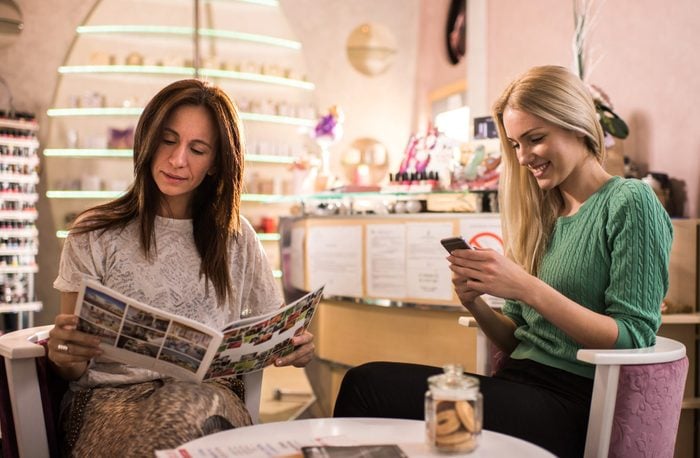
Showing up early
It goes without saying that being late is a no-no, but so is showing up super early. You may think arriving before your appointment time will allow you to sneak in a bit earlier and maybe get an extra-long conditioning treatment, but that’s unlikely. “Given a stylist’s schedule, there is a big chance a client will have to wait until it’s their time,” says De La Cruz. “Also, being too early can overwhelm a stylist because they may feel rushed during the current appointment.” Even if you don’t mind waiting, knowing that you’re sitting there can put the pressure on your hairdresser.
Do this instead: You can always call the salon the morning of your appointment to see if your stylist might be free a bit earlier than your appointment. Otherwise, don’t show up more than 10 minutes before your scheduled time.
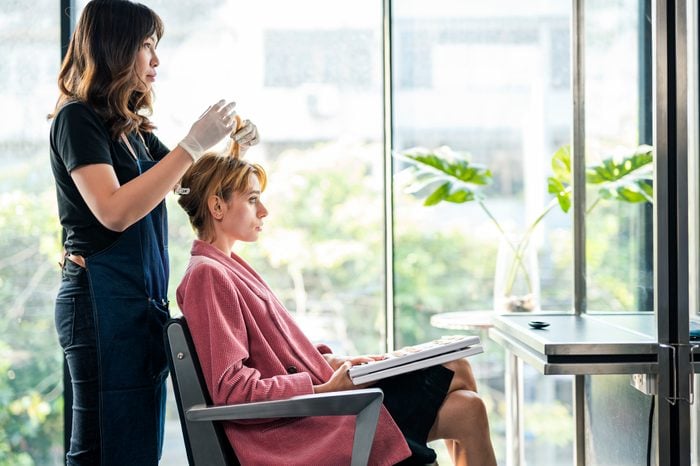
Not being specific
One of the first things a stylist will say to you when you sit down in their chair is something along the lines of, “What would you like to do today?” This is your chance to tell them the type of cut or color you’re looking for—and to be very specific. They’re the expert, yes, but it’s your hair. “Often, a bad cut happens when the client and stylist don’t have a clear line of communication,” explains Silvia Ferdin, an educator coach at Aveda Arts & Science in San Antonio, Texas. You may worry that you’ll come off as pushy or demanding by detailing your vision, but when a hairdresser doesn’t know what you are really looking for, it makes their job much harder.
Do this instead: Bring photos of styles you like to your appointment (whether it’s celebrity pictures of the best hairstyles for women over 40 or photos of you from the past). This will give your hairdresser an idea of what you want. Tell them what you like about it, then ask if your stylist thinks it will work for your face shape and hair texture. They may recommend a few adjustments, but having a specific starting point that you both can see will help avoid miscommunication and mishaps.
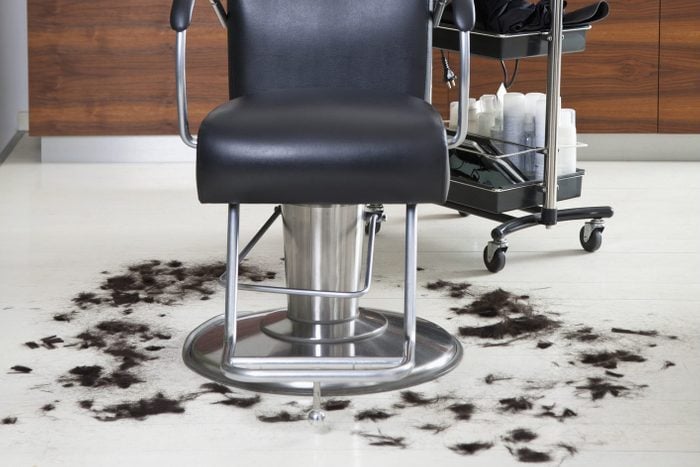
Dusting off the cut hair
Whether you get a blunt cut, disconnected layers or some other fancy hairstyle, hair is bound to fall on the protective cape. Some may even get on the back of your neck or your shoes. Dusting it off doesn’t do your hairdresser any favors. In fact, it makes their job harder. “If hair is collecting on the cape at your shoulders or in your lap, we would rather you sit still,” says Molly Getz, a Sam Villa ambassador, Redken artist and stylist at Soto Signature Salon and Spa in Perrsyburg, Ohio. Moving around too much forces the person cutting your hair to stop and wait while you adjust.
Do this instead: If the hair is not bothering you, just leave it. If it is tickling you or making you itchy, Getz suggests asking your stylist if either you can brush it off or they can. This will allow them to stop what they’re doing before you move.

Using terms of endearment for your stylist
Sweetie, hun, babe—terms of endearment may seem nice, but the salon is not the place for them. “They can be taken the wrong way very easily,” says Getz. While it may be fine to call a partner or pal by those names, remember that your stylist is a professional and should be treated as such. When you use pet names, it can make them feel like you don’t take them seriously or don’t value their services. This is something flight attendants and restaurant staffers don’t like either.
Do this instead: Stick with your stylist’s given name. If they have a name that seems like it could easily be shortened (think Elizabeth to Beth or Harold to Harry), ask before you start shortening their name.

Grabbing what you need
Want a spritz of hairspray on your way out to help your blowout last? Or maybe you want to run a brush through your hair while your hairdresser is getting set up. You can just grab what you need quickly to save them the trouble of having to hand it over, right? Wrong. “Let your stylist get you whatever it is that you need,” says De La Cruz. “Don’t go into their things to grab a comb or blow-dryer. Always ask first—it is just a level of respect and boundaries.” Think of it this way: You wouldn’t want your stylist to rummage through your purse to find something—and the same goes for their stuff.
Do this instead: Simply ask for whatever you need. Your stylist will be happy to hand you a comb or something else—or even do whatever you need themselves. Not only does asking respect their boundaries and property, but it can also keep you safe. You never know where their sharp scissors or razor blades may be, so rooting around in unfamiliar territory isn’t the smartest idea.
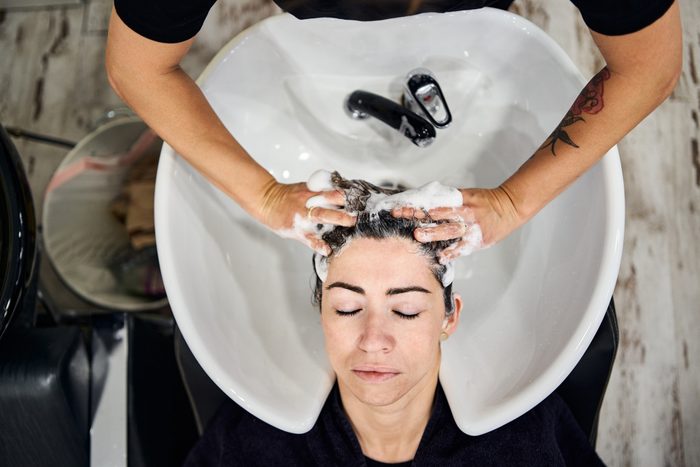
Anticipating when they need you to move
Over the course of a haircut, your stylist will likely ask you to point your chin down, keep your head straight or even look to the side. These small movements can help them give you a more precise cut. But don’t try to anticipate when they want you to move. “Salons are home to sharp scissors, hot styling tools and chemicals,” says Kristina Maccaro, colorist and owner of Love Lane Salon in Jersey City, New Jersey. “We want to avoid any unnecessary accidents, so tell us if you are going to adjust your positioning.”
Do this instead: Even better than warning a stylist that you’re going to move? Waiting until they tell you they need you to change your position. If you’re getting a hairstyle to look younger, they may need to focus on cutting layers, so they’ll have you look down more. If you’re going with a blunt bob, it may be crucial to look straight ahead. Trust that they’ll let you know when to adjust your head, because they will!
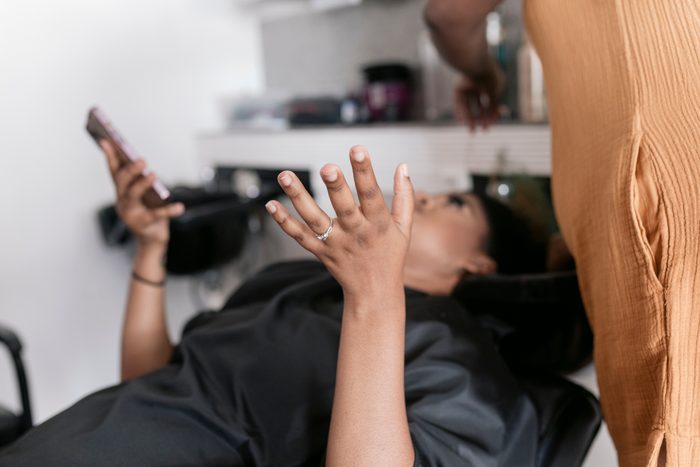
Chatting nonstop
Don’t feel like you have to be a chatty Cathy. “Conversation is up to you. A professional hairstylist will be able to read the vibe you are trying to have for your service,” says Maccaro. “If you are looking to chat, go for it. If you prefer a quieter appointment, we’re not offended.” In other words, it is not your responsibility to entertain the person doing your hair.
Do this instead: Not in the mood to chat? No problem. Be cordial at the start of your appointment and then explain that you’ve had a busy week and are looking forward to some time in the chair to unwind and quiet your mind. They should pick up on what you’re saying and follow your lead. And when you do talk, make sure to avoid these rude conversation habits.

Showing up with dirty hair
It makes sense that you’d hit up the salon with dirty hair—after all, they’re going to use a great shampoo on you. Plus, isn’t second- or third-day hair better for certain services? “It’s a hair myth that dirty hair takes color better,” says Maccaro, who advises showing up with clean hair. Plus, it’s helpful for a stylist to see how you normally style your hair. This will give them the intel they need if they’re placing highlights or giving you a cut.
Do this instead: If you’re getting your strands colored, call ahead and ask what you should do. Your stylist may want clean hair with no products in it. If you’re getting a cut, style your hair like you do most days so they can see how you tend to wear it.
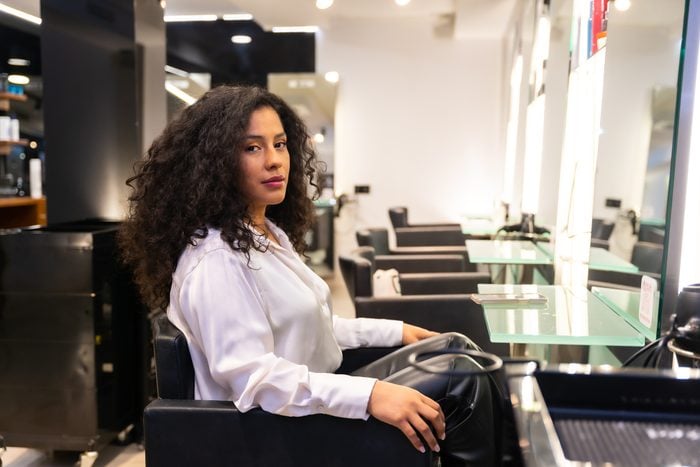
Dressing up
Whether you go to a fancy-schmancy salon or a casual spot, there’s no need to get all done up for your hairdresser. In fact, dressier clothes can be problematic when you sit in the chair. Be mindful of what you wear to the salon,” says Getz. “Turtlenecks, collars and hoods can be bulky, and they could potentially make it tougher to keep the color, hair and water at the shampoo bowl from getting on your clothes.”
Do this instead: The goal should be to wear a top that can easily stay put under the protective cape they give you at the salon. T-shirts and collarless shirts tend to work just fine. Another wardrobe pointer? Avoid open-toed shoes, since falling hair can get stuck on exposed toes.
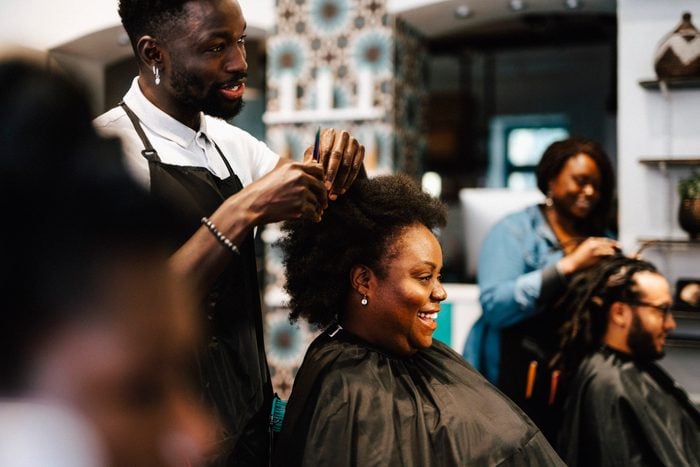
Apologizing for your hair
“You do not need to apologize for the appearance of your hair when you arrive,” says Getz. Whether it’s been a long time since your last cut or you haven’t figured out how to grow out gray hair, there is absolutely no reason to apologize for the state of your strands. In fact, Getz says rather than apologizing, you can use it as an opportunity to ask for pointers. If grays are giving you trouble, ask which root touch-up kits your stylist recommends, or how to style your hair if you’ve been struggling. This conversation may also help your stylist tweak your hair to better suit your needs.
Do this instead: Rather than feeling bad, be frank about whatever it is you may be self-conscious about. Your hairdresser is a professional and has likely seen it all. They’re there to be a resource, not to judge you. If you’re busy apologizing, you’re wasting time that you could be using to get helpful advice.
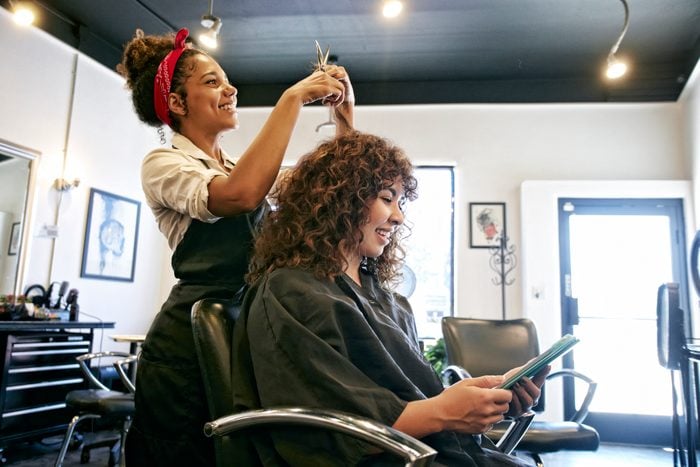
Avoiding your phone
It’s rude to check your phone a lot when you’re out to dinner with friends, but the same rule doesn’t apply at the salon. “As long as your phone is not in the way and you aren’t moving your head, using a phone isn’t a problem,” says Getz. One caveat: Jabbering away on unnecessary calls during your entire appointment. Not only can this be distracting, but the salon is a place where many people go to relax, and no one wants to have to hear someone else’s long, personal conversation.
Do this instead: Avoid being on your phone when you first sit down, says Getz. This is the time usually reserved for a consultation to figure out what will be done during your appointment, so it’s important to be fully present. After that, it’s fine to catch up on email, scroll through social media or play a game—provided your head doesn’t move around much.
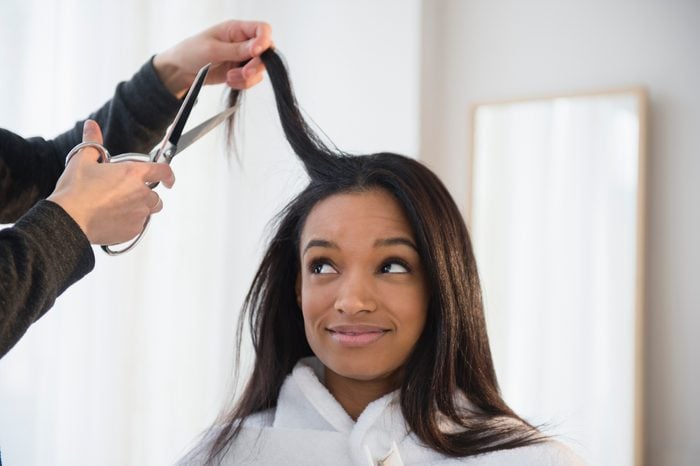
Keeping quiet if you don’t like the end result
You’ve sat through the cut and blow-dry, and when the time comes to reveal the finished look … you don’t love it. Ugh. That’s tough. And there’s no doubt that it can be uncomfortable to let someone know that you aren’t thrilled with their work. But staying quiet is taking politeness way too far. “You should never stay quiet if you’re unhappy,” says De La Cruz. “Your stylist appreciates the honesty because it’s the only way they can correct it and keep you as a happy, loyal client.”
Do this instead: Pointing out what you don’t like may feel more difficult if you are worried about hurting someone’s feelings (which, again, you really don’t need to concern yourself with). Instead, focus on what needs to be done to get the cut to a place you’ll feel better about. Say you were hoping for some more face-framing layers or that you would love to see a little more length gone—whatever it is that could help you fall in love with your new look.

Making a big show out of tipping
Did your stylist pick the best hair color for your skin tone? Or maybe they gave you the cut of your dreams. Tipping is a great way to show your appreciation. But don’t do so with a ton of fanfare. “Be discreet about tips. Don’t come back into the salon waving money,” says Ghanima Abdullah, a stylist and cosmetologist at The Right Hairstyles. “This might make your stylist feel cheap.”
Do this instead: Tell them how much you love your cut, then leave a good tip at the front in an envelope with their name on it, says Abdullah. Another option is to hand the tip to them discreetly and say thank you.
Sources:
- Jon Carlos De La Cruz, hairstylist in Hollywood, California
- Silvia Ferdin, educator coach at Aveda Arts & Science in San Antonio, Texas
- Molly Getz, Sam Villa ambassador, Redken artist and stylist at Soto Signature Salon and Spa in Perrsyburg, Ohio
- Kristina Maccaro, colorist and owner of Love Lane Salon in Jersey City, New Jersey
- Ghanima Abdullah, stylist and cosmetologist at The Right Hairstyles
